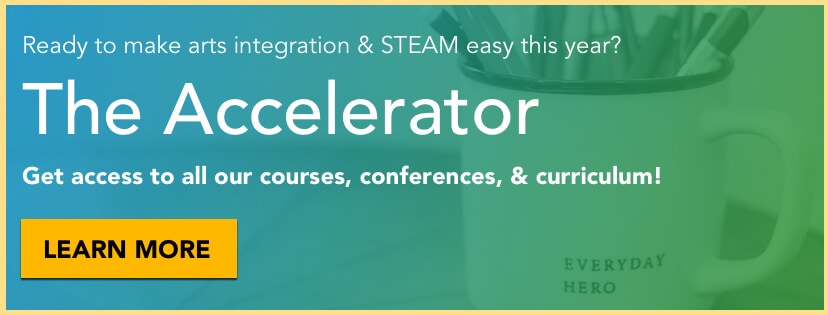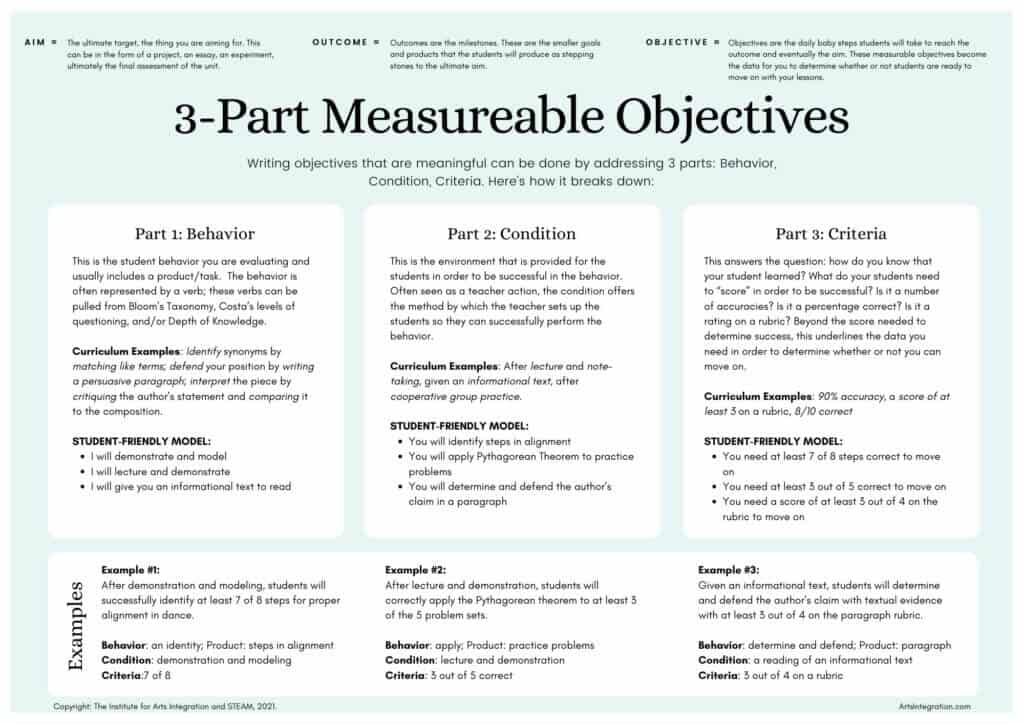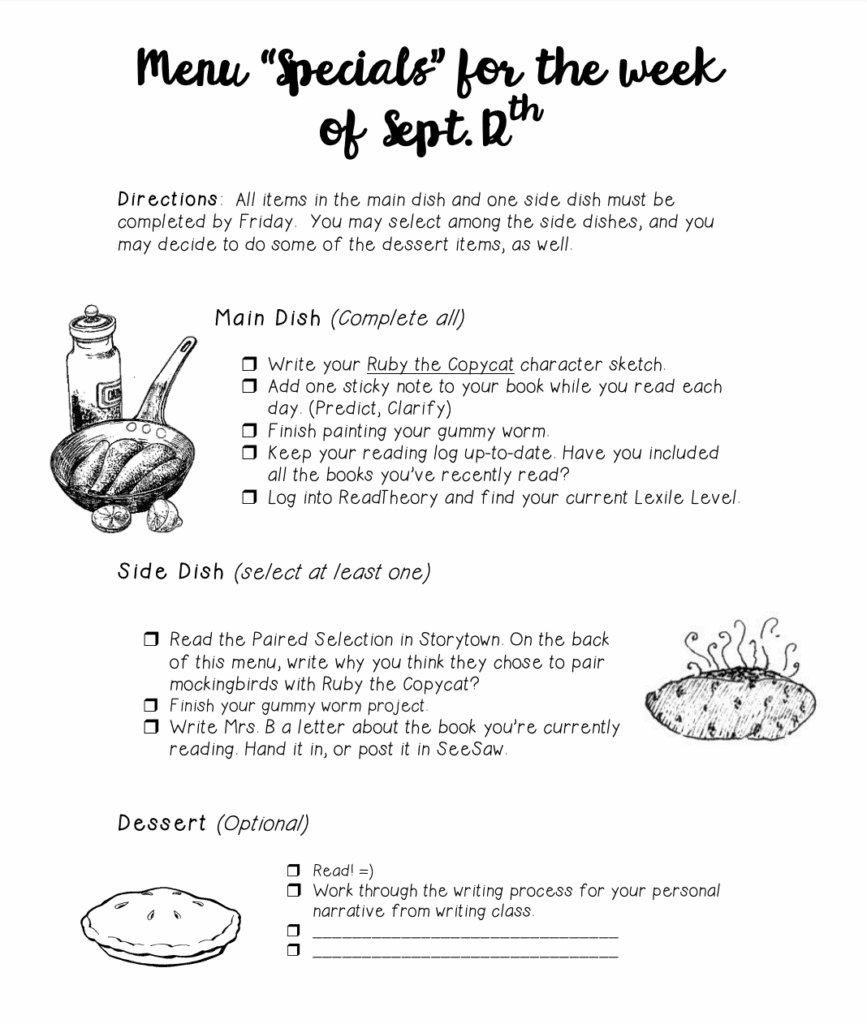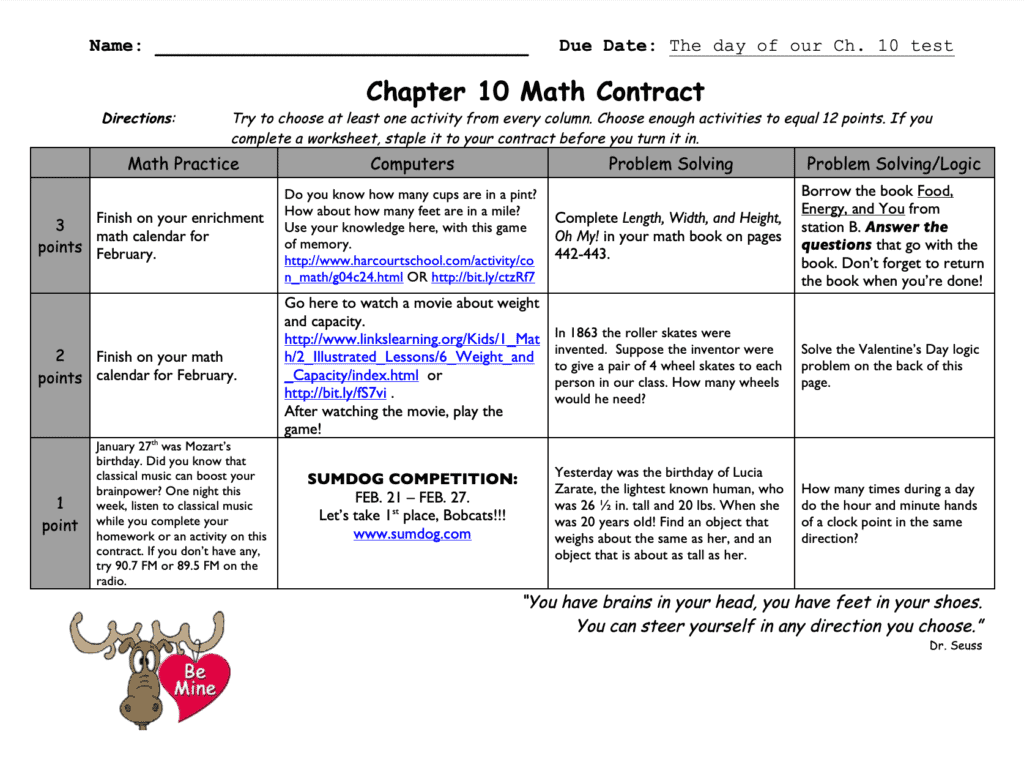JOIN US FOR THE 2025 ARTS INTEGRATION & STEAM CONFERENCE – LEARN MORE
Each section will take these eight characteristics and use them to define what authentic engagement looks like in both STEAM and Arts Integration. We’ll provide templates and rubrics to self-assess, and offer downloadable resources and ultimately define engagement in an actionable way.
Personal Response
The level of personal response is imperative to building engagement in STEAM. In order to be authentically engaged, students must be allowed to develop their own views on the content and be supported in those views. If we take a look at “traditional” teaching or the imparting of knowledge from one to another, students experience low levels of Bloom’s including knowledge and understanding. This is not a bad thing. When we begin new content information it is important to lay a foundation of facts and information. However, once that information is presented we need to move students up in the levels of rigor, which will, in turn, increase their level of engagement. Let’s take a look at Antonietti’s suggestions for developing authentic engagement through personal response.
Supported predictions
Allow students to predict what’s next. Begin by giving students only the basic information and then ask them questions that require them to use that information to predict next steps. You will be surprised how often students can predict the next information correctly.
Opinions
When preparing for the plethora of impending standardized tests, the idea of allowing students to grapple with information and build their own opinions may feel like a waste of time, but it’s not. Give students the opportunity to talk about and defend their opinions on the content information. Not only does this increase authentic engagement, but it also helps to develop the skills to approach a situation from multiple points, which will be helpful in their tests.
Connections
Help students to make connections. Whether they are connecting to personal experience, other subjects, hobbies, and/or activities, the connections that are made will not only increase the ability to retain information by giving them a concrete “go-to” for remembering information, it will also increase authentic engagement because they are able to articulate value in the content by connecting it to something they perceive to be valuable.
Comparisons
Comparisons are also an opportunity for students to see how everything they are learning has some sort of relationship. Help students to make comparisons between different factors of your content as well as comparisons between different content.
Analogies
Although analogies have been removed from the SATs, it is still an effective way to increase authentic engagement and retention. Offer examples, “this is like____” and then allow students to do the same thing.
Summary Statements
If you are familiar with Focused Notes The Cornell Way, then you are used to helping students to design summary statements at the end of their notes. If not, it’s ok, just implement an opportunity for students to summarize the information in their own way. This works best when students are working from an essential question, then after they take their notes and receive the content information, have them answer the essential question as a summary.
Explanations
Allow students to explain information in their own way. There are multiple ways for students to explain information. Consider using methods they are excited about like social media, pictures, and videos.
Authentic Engagement via Personal Response
Pushing students past compliance and into the realm of authentic engagement is not easy, but including opportunities for students to use, grapple, and value their own personal response is. None of these require you to rewrite the curriculum but it does require you to alter your line of questioning. This can be as simple as encouraging the opportunity to predict, connect, or explain in an opening or closing activity.
Novelty & Variety
Novelty and Variety are also important for building student engagement in STEAM. In order to be authentically engaged, students must be allotted the opportunity to demonstrate knowledge in a variety of ways. The more students are able to create, design, and engineer, the higher they move up Bloom’s ladder. Let’s take a look at Antonietti’s suggestions for developing authentic engagement through novelty and variety.
Variety of Products
Incorporating a variety of products will help increase a student’s ability to engage, and the arts are a great way to provide that variety. Offer multiple ways for students to prove their knowledge including options in visual, musical, and movement-based demonstrations.
Diverse Perspectives
Allow students to look through multiple lenses. Having students “step into another’s shoes” or “speak in the voice of” will provide novelty in the classroom. So instead of approaching content from the eyes of students or teachers, have students use characters (fictional or non-fictional), historical figures, scientists, their family, or their favorite basketball player while also rationalizing a different perspective.
Layered Interests
Take the time to survey students and capitalize on their interests. Layer these interests into the variety of products students can produce and the diverse perspectives students can view.
Simulations & Role-Play
Let students perform! When we bring the performing arts into the classroom we watch student engagement soar. Any content can be transformed into simulations and role-play. Having students plan, produce, and perform their knowledge is one of the highest levels of rigor and creates even higher levels of engagement.
Games & Competitions
Our students are always amidst a competition. Whether in athletics, after-school activities, dance, improvisation troupes, or even advanced placement or SAT preparation, everything is a competition. Bringing a playful competitive spirit into the classroom will quickly increase student engagement.
Authentic Engagement via Novelty & Variety
Bringing novelty and variety into the classroom can be easy. All that needs to be done is changing up the way students demonstrate their knowledge. You can still present your content but instead of having students just regurgitate it back to you in the form of a written response or a multiple choice quiz, have them share their new knowledge in a variety of ways. When we create these opportunities in the classroom, our students are engaged, they retain the information, and perform better in the ultimate assessments.
Emotional & Intellectual Safety
Now let’s take a look at Emotional and Intellectual Safety. This concept is a foundation for student engagement – especially in STEAM – when we are asking a student to step outside of the traditional education box and push students to create, design, and engineer.
In order to create a space that is emotionally and intellectually safe for our students, we must first build a community of trust. It is imperative that we lay this foundation at the beginning of the year and cultivate it throughout the year in order to create a safe space for our students. Continue to build trust by strengthening the relationships and community within the classroom, encouraging respect and listening, and sharing openly and honestly. Once this mutual community respect is established, our students can feel comfortable sharing within the community, and this comfort will increase student engagement because now we can push students into higher levels of thinking.
Have Students Explain How/Why
Having children defend or justify their answers will increase student engagement, especially in some of our STEAM subjects like science and math where there are traditionally convergent answers. When students feel safe intellectually, they will be more willing to share their rationale.
Encourage Students to Take Risks
When students feel safe we can push them a little more out of their comfort zones and use various levels of questioning that will help them take risks with their understanding and their knowledge.
Help Students to Reason First and Answer Second
Grappling with information, reasoning and deducing, and potentially determining answers that might be wrong can put students into a very vulnerable place. However, if we have strengthened the foundation of the “community” within the classroom, and our students feel intellectually safe, we can help them develop their reasoning skills and make those hold more importance than just an answer.
Ultimately, if you students feel intellectually and emotionally safe within our classroom communities then they will take the risks needed for them to become authentically engaged.
Sense of Audience
Another important concept for building student engagement is a Sense of Audience. In order to be authentically engaged, students must know there is a greater audience. Below are some strategies to help your students broaden their sense of audience.
Increased Level of Concern
By defining an audience, there is an increased level of concern. Design scenarios that can actually play out so that the level of concern, or people who are concerned, is heightened. When students know that their work will be showcased beyond the classroom there is a heightened level of importance. Let’s face it: if we are requesting that our students complete work out of compliance, we are going to get the bare minimum. But when “the world awaits” and there is a feeling of pure accomplishment because someone other than the teachers is going to view it, engagement is increased.
Connections to Audience/Purpose
When students know there is an audience, then the purpose is exposed and they tend to be more engaged. This level of student engagement can’t be fabricated, so be sure the audience you present is a real audience. Whether it’s displaying their work on Instagram or displaying it in the lobby of the school, it must be an authentic audience in order for the purpose and audience to connect.
Voice
Give students a voice. The more that their creations make a difference in their world, the more relevant the purpose, real the audience, and engaged the student.
Responsibility to the Group
Collaborate or group work is not always favorable for students. More often than not, one or two students complete the work and the others ride coattails. Alleviate that by ensuring that there is an audience, and group members contributions will be highlighted or showcased by name. Now not only do they have a responsibility to themselves and their audience, they have a responsibility to the group.
Clear & Modeled Expectations
So often we tell students what we want to see, but we don’t show them what it actually looks like. Clear/Modeled Expectations are imperative to building student engagement in STEAM. In order to be authentically engaged, students must know exactly what is expected and furthermore, what that expectation tangibly looks like. Let’s take a look at some of Antonietti’s suggestions for developing authentic engagement through Clear/Modeled Expectations.
Clear Objective of Activity and Learning
Objectives are key to ensuring our students know the daily expectations and can articulate the criteria for their success. Even when working with the most independent classroom set up (such as AP studio art or dance composition), empowering our students with the ability to articulate and create their daily objectives is an invaluable skill. The 3-part measurable objective model could be of great use here:
Visual Exemplars
Teachers often don’t think about actually providing our students with exemplars. We want our students to do great work, but we don’t show them what great work actually looks like! Students need to see what excellent looks like so they can work toward that expectation. This is also a great place for you to involve Sense of Audience. Let students know that their exemplar work will be showcased for the next generation, to force them to invest more of themselves into their work.
Rubrics and Self-Assessment
Rubrics are your friends! The more you design and implement rubrics, the better your students understand the expectation and actually meet it. Ideally as a teacher, you should have some go-to content rubrics that are used frequently and not changed so that the students become very familiar with them. But on a larger scale, there should be department and school-wide rubrics that the students use for cross-curricular expectations. For example, an expected paragraph rubric is a great idea for a school-wide venture. This way paragraphs in science are evaluated the same as in English and in history. It becomes a known expectation that students are familiar and comfortable with. This will engage students because they are prepared and know exactly what is expected.
Clear Formats and Procedures
It is no secret that we are all more engaged when we know exactly what we need to do. As you build interactive activities and tasks like gallery walks, stations, and group work, ensure that your procedures are clear, explained, posted, and modeled.
Learning with Others
Not only are clear and modeled expectations a vital part of authentic student engagement, but Collaborative Learning experiences are also. In a 2015 Washington Post article, education writer Jeffrey Selingo describes how employers find current graduates lacking in soft skills like collaboration, problem-solving, oral communication, and leadership. We often manufacture group work in our classes with the intent to offer necessary collaborative learning for our students, but are we truly giving them group work?
Generally, we believe if we put students in groups, then we are creating an engaging environment for them, but the truth is only genuine group work is engaging. For example, if you have students work on an assignment that could be an individual assignment – yet you allow them to work in a group – then they are not actually completing group work. They are just working alongside a friend.
Before you design group work or partner work, ask yourself if this genuine group work. Meaning, do students have to be in groups in order to successfully accomplish the objective? If yes, great, but if the answer is no, then either revise the expectation so it must be completed in groups in order to be successful, or take them out of groups. Don’t forget to create a clear protocol for any group work. Determine who is responsible for what, what the roles of the members are, how the members will evaluate themselves, and the group as a whole.
Learning must have a social component, and Antonetti suggests activities like Think, Pair, Share; Literature Circles; Small Group Discussions; Reciprocal Teaching, and Peer Revision or Review to encourage genuine group work.
Class Discussions for Collaboration
Class discussions are a great collaborative strategy, but again, clear expectations must be set beforehand. How are you going to discuss? How are you going to set up the discussion? How are you going to make sure everyone has and uses their voice? How are you going to evaluate the discussion? How are you going to ensure the discussion was successful, and if it isn’t, what are you going to do to follow up?
And more often than not, class discussions are usually the teacher leading the discussion, with an occasional lower-level question posed to the class and a couple of students responding. This is not a genuine class discussion. In order to properly practice Learning with Others, students must get the opportunity to use their voices, and present claims, and defend ideals. We want to be sure all students are engaged and participating, the discussion is organized and not chaotic, and that we are teaching students the skill of listening to understand, not just listening to reply.
Discussion Design
Students should know and be able to create the proper environment for a class discussion whether it be a circle, square, horseshoe, etc. They should also learn what to say and how to say it. Practice Accountable Talk Stems with your students, which are ways to initiate and continue discussions. Design academic controversies that spark discussion, where students will clearly have an opinion. The more relevant to “their world” the topic is, the more they are going to want to discuss it.
You must also consider the assessment aspect. How are you evaluating the students? Is it solely participation-based? Do you have a rubric where you are checking for specific things within the discussion? Are students a part of the evaluation process? Are they evaluating themselves as well as others during the discussion? The answer should be yes to all of that.
Now that we have highlighted some of the basic procedures, determine the format. There are a plethora of discussion formats out there, each with a multitude of variations so it is important you choose the one that you are most comfortable facilitating and, as always, tailor it to the needs of your students.
Choice
If you’re looking to engage your students on a whole other level, look no further than harnessing the power of choice. While this is proven through research, sometimes it can be difficult to transfer best practice research to something tangible (and possible) in the classroom. In the book The Highly Engaged Classroom, Dr. Robert Marzano explains why student choice is essential in our classrooms, and he offers tips for teachers on how to incorporate choice in practical ways.
Marzano found that students perceive classroom activities as more important when they are given choices. It increases intrinsic motivation, increasing student effort and task performance, which therefore boosts the amount that students can learn from an activity. To see these benefits, we need to make sure to “…create choices that are robust enough for students to feel that their decision has an impact on their learning.” Students, especially advanced learners, can easily identify when activities are not meaningful.
The concept of student choice is hard to argue, but it can also be hard to make the dream become a reality. In the long run, it can help students practice decision-making, self-regulation, time management, and organization.
User-Friendly Ideas for Student Choice
Let’s take a look at some ideas for managing student choice. When it comes to task development, it is important to really get to know your students and their collective interests. This will allow you to tailor learning activities to create more buy-in since students will know you have their interests in mind. However, some choices should be flexible so that students can personalize them.
Marzano explains that choice can be provided in four ways: choice of task, choice of reporting formats, choice of learning goals, and choice of behaviors. It’s important to offer a bit of all of these. However, it is also important to limit them so that students don’t get overwhelmed by decision making. For example, create learning menus and choice boards for students in an attempt to rotate choices of task and reporting formats, but when it comes to learning goals, assist students by conferencing with them individually.
Learning Menus
Learning Menus function as a flexible to-do list. Students have Must Do’s, which are their “Main Courses”, “Side Dishes”, which are available if students finish the main dishes, and “Desserts” if students finish a side dish. This ensures that students know my idea of the order of importance, and it provides them with a checklist to chunk larger projects, making them less overwhelming. For your convenience, we’ve created an editable learning menu for you.
Choice Boards
Choice boards are great for independent work time, or as an anchor activity for students when they finish before others in class. You can design these with a variety of enrichment choices, based on Bloom’s Taxonomy, related to any topic. For example, use these in your math class and create one per chapter or topic. The lower-level activities are worth one point, and higher-level activities are worth three points. You can ask students to reach a certain amount of points by the end of the chapter, and sometimes tell students there is a certain “mystery” box activity that will be rewarded, just to keep it interesting.
Or, you can ask students to complete a Tic Tac Toe pattern. Choice Boards also prevent students from ever having a moment with nothing to do. It helps with behavior problems and it ensures that students are consistently working their brains. Take a look at this sample math choice board, a blank spelling choice board, and a template to use when creating your own.
Monitoring Learning
Formative assessment is crucial for all students, and it is so helpful when differentiating for our learners. When using this student choice-based approach, it is very important to actively monitor the learning that occurs, so that you can assist students in making wise decisions. It is also great to get a “read” on class knowledge. If many students haven’t grasped a concept you expected them to, you can reteach to clear up misconceptions if necessary and design a targeted activity as a “must-do” that gives some extra practice. By strategically providing this targeted choice, we are able to respond to the needs of individual learners and still tap into all the benefits that choice provides.
There are many ways to end a lesson with a quick check for understanding or misconceptions. For example, try the “Ticket Out” method. Pass the exit tickets out at the beginning of class so that you can discuss the essential question with your students, and then begin with a review. At the end of class, stop 5 minutes early for students to complete the Ticket Out the Door. You can use the information to see what concepts students have grasped the best, and where they may need help still. There are many free Exit Ticket templates that work for every subject area.
Authenticity
We’ve talked a lot about what authenticity looks like, but what is it really? Antonetti defines authenticity as connections to experience or prior knowledge. He breaks this down into 8 tangible approaches to authenticity through:
- Relevance to age/group
- Tasks that represent the personalities of the learners
- Real-life activities
- Inquiry or discovery learning
- Current events/issues
- Hands-on manipulatives
- Transfer or synthesis beyond content
- and Extension of workplace activities.
Real World vs Relevant
It’s important to remember that the word authentic gets used interchangeably with real-world. Real-world projects. Real-world problems. Real-world situations. Wanting our classroom work to mirror the real world is definitely a good thing and builds on 21st century skills, but sometimes real world becomes out of their world.
When we think “real world” we unintentionally think of our own personal world. So we tend to build learning opportunities that place students in job or life experiences that are often pulled from our personal schema, like: “you are the CEO of a company…”or “you have just bought your first home.” This is not real to them. Situations like these are out of their world. In order to be authentically real-world, we must provide opportunities that are relevant to our students’ current world.
The Glossary of Education Reform defines authentic learning as tasks where students learn by doing, that mirror life’s complexities, and where students contribute to communities. Furthermore, they promote the purpose of school as more than a test score, that we should be helping students obtain the skills necessary to be successful in life.
Before we can help students to learn by doing, mirroring life, or contributing to their communities, we need to step into their world. We have to give them situations and connections that are real to their world now. If we offer students connections and situations that are so close to home that they can actually, physically, right this minute, do something about it, then we are giving them their-world experiences.
For example, design every lesson in Health class to lead to the planning and production of a school-wide health fair. Or, while studying argument in English class, have students develop a proposal to the school board that argues for the change in uniform or cell phone policy. Then actually do it. There are many models for excellent real-world learning but one of our favorites is project-based learning. If you start implementing those kinds of tasks, you’ll get a lot closer to offering true authentic real-world learning experiences.







